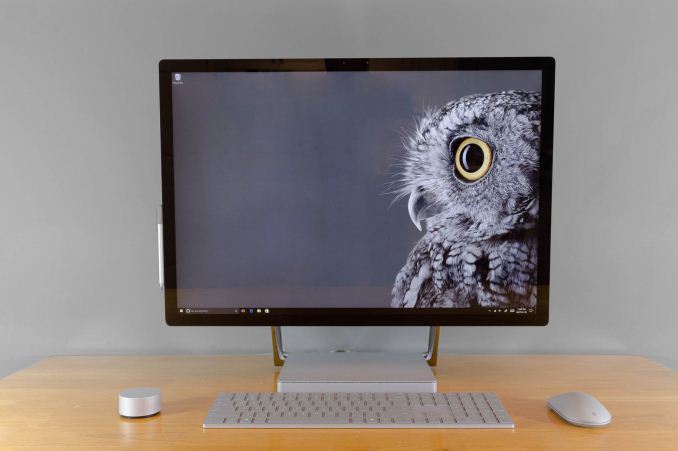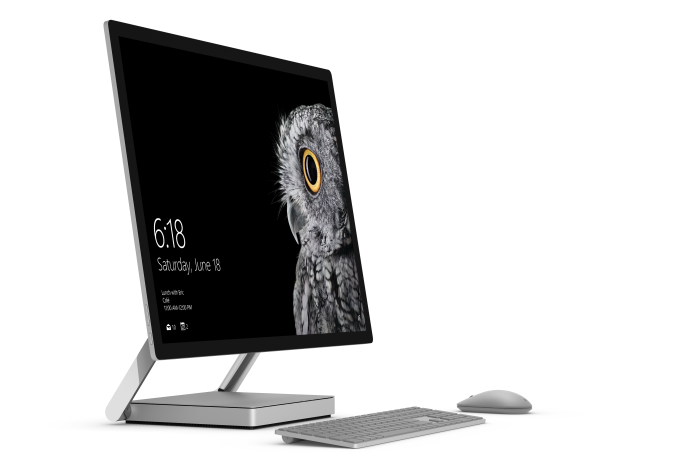The Microsoft Surface Studio Review
by Brett Howse on January 20, 2017 8:00 AM EST- Posted in
- Desktop
- Microsoft
- Surface
- Surface Studio

Microsoft has only been in the PC system game for a few years now, but over the last couple of years they have made a lot of progress rather quickly. These days they have a solid foundation of products available, with the Surface Pro 4 being one of the best convertible tablets, the Surface Book being a very solid convertible laptop, and also the more specialized products like the Hololens, and Surface Hub. Going into their October 2016 event, the one missing piece of their PC product lineup was a desktop computer, but with the announcement and release of the Surface Studio, that particular gap has now been filled.
But the Surface Studio is not your typical desktop PC. Even at first glance, the sleek, beautiful lines are readily apparent, and once powered on, it is rare for anyone to first glimpse the 28.125-inch 4500x3000 display and not say “wow”. It’s not only the very high resolution, but also the 3:2 aspect ratio that is unheard of in this segment, that makes the display stand out as something unique.
Microsoft has become one of the superlative hardware manufacturers in only the short span of four years or so, and the Surface Studio is one of their finest designs yet. However, from the very first Surface RT, Microsoft always tries to add something different, but more importantly interesting, to their designs, and in the case of the Surface Studio, it is the zero-gravity hinge, which allows the all-in-one to be quickly and easily tilted back to a 20° angle, letting it be used as a huge, digital drafting table. Microsoft announced the Surface Studio at their October Windows event, where they also announced the next Windows 10 Update, called the Creator’s Update, and it is wonderful to see them building hardware to truly bring out the exclusive features of their software.
Packed into the base of the Surface Studio is a laptop-class computer, with three different models available now. The base model, coming in at $2999, features an Intel Core i5-6440HQ processor, 8 GB of memory, a 1 TB hybrid drive with a 64 GB SSD cache, and a NVIDIA GeForce GTX 965M GPU. The mid-level model, which costs $3499, bumps the CPU up to an Intel Core i7-6820HQ, doubles the RAM to 16 GB, and doubles the SSD cache to a PCIe 128 GB model, with the same 1 TB HDD and GTX 965M. The highest priced model, at $4199, is an Intel Core i7-6820HQ, 32 GB of RAM, a 2 TB hybrid drive with a 128 GB PCIe cache, and a NVIDIA GTX 980M GPU with 4 GB of memory.
| Microsoft Surface Studio | ||||||
| Base | Middle | Top (As Tested) | ||||
| CPU | Intel Core i5-6440HQ Quad-Core, 2.6-3.5 GHz 6 MB Cache, 45W TDP, No Hyperthreading |
Intel Core i7-6820HQ Quad-Core, 2.7-3.6 GHz 8 MB Cache, 45W TDP, Hyperthreading |
||||
| GPU | NVIDIA GTX 965M 1024 CUDA Cores 944 Mhz + Boost 2 GB GDDR5 128-bit memory |
NVIDIA GTX 980M 1536 CUDA Cores 1038 Mhz + Boost 4 GB GDDR5 256-bit memory |
||||
| RAM | 8 GB DDR4 | 16 GB DDR4 | 32 GB DDR4 | |||
| Storage | 1 TB Hybrid Drive 64 GB SATA SSD Cache / 1 TB SATA HDD |
1 TB Hybrid Drive 128 GB PCIe SSD Cache / 1 TB SATA HDD |
2 TB Hybrid Drive 128 GB PCIe SSD Cache / 2 TB SATA HDD |
|||
| IO | 4 USB 3.0 ports - one high power port Full size SD Card Slot Headset Jack Xbox Wireless Connectivity DisplayPort |
|||||
| Display | 28.125-inch PixelSense Display 4500 x 3000 resolution 192 DPI sRGB, DCI-P3, P3 D65 color modes |
|||||
| Webcam | 5 MP Webcam Windows Hello Facial Recognition |
|||||
| Networking | Marvel AVASTAR 802.11ac Intel I219-LM Gigabit Ethernet |
|||||
| Price | $2,999 | $3,499 | $4,199 | |||
There was quite a bit of discussion at the time of the Surface Studio launch over the fact that it was equipped with older technology. Intel’s Kaby Lake quad-core parts just launched at CES this year, so Skylake quad-core CPUs were the latest generation available at launch. The Maxwell based graphics options chosen were not the latest generation mobile graphics from NVIDIA, with the GTX 965M and GTX 980M available in the Studio. The Pascal based GTX 1060 and GTX 1070 would have been much more powerful substitutes, but they are not pin-compatible drop-in components with the Maxwell GPUs in the Surface Studio, meaning a new board design and thermal considerations would have been necessary late in the design phase, and Microsoft appears to have been conservative here to avoid missing their launch window.
Microsoft has also been very conservative with their I/O choices, with four USB 3.0 Type-A ports on the back of the Studio, along with a SD card slot, and mini DisplayPort. As with the Surface Pro 4 and Surface Book, Microsoft has continued to provide only the older USB-A ports, and not even offer a single USB-C port, let alone with Thunderbolt. Anyone purchasing a Studio will likely be using it for several years, and the lack of USB-C is going to be an issue in the future, if not already today. The Surface team really needs to reconsider this as it is already a detriment to not include any.
There also must be some questions raised about the use of a hybrid drive in a PC of this price. We’ll dig in to the experience later, but Microsoft could and should offer a larger SSD as the boot disk, complimented by a HDD as a secondary disk, at least on the highest end model. A 512 GB NVMe SSD as the boot drive would appease much of the criticism. The computer does cost over $4000 after all, and while much of the cost of the device is in the display, SSDs have been the biggest improvement in user experience on the PC in a long time.











197 Comments
View All Comments
nerd1 - Sunday, January 22, 2017 - link
And for remaining $1500, I can build a nice, silent watercooled system with 1080 GPU at least.fanofanand - Monday, January 23, 2017 - link
Because then they couldn't milk you dry. If they sold this for $1500, who in their right mind would buy the full kit for $4k when they could add it to a $1500 machine that would mop the floor with this? Duh, because profits!BillBear - Sunday, January 22, 2017 - link
This isn't being priced as a tool for home. It's being priced as a professional tool for artists.When professional artists draw, they want to be able to taper the thickness of a line based on how much pressure they put on the stylus.
Surface Studio is just not sensitive enough to get a smoothly tapering line, especially towards the bottom of the scale. This is not a problem you have with Wacom's products.
Ro_Ja - Monday, January 23, 2017 - link
Could've used a GTX 1060 for the base model, a 1070 on the next one and a 1080 for the high end variant.Thorin.2604 - Monday, January 23, 2017 - link
you need to hackint0sh it - to get a decent Designdesktophasseb64 - Monday, January 23, 2017 - link
ohh my!! Reading first page--> price tag and that small SSD!! Hybrid drive??? 2017!!haha!! End of reading
phexac - Tuesday, January 24, 2017 - link
One thing this review doesn't mention is smoothness of the interface. I played around with a base model of this at the MSFT store. While I cannot say what the models with higher end GPUs would perform like, the model that I used was severeky handicapped by the GPU. Just moving windows around the screen was super jaggy. IMO, smooth performance is key to a machine like that. This is something Apple understands with its devices, both mobile and Macs.MSFT creates a PC based on a gorgeous high definition screen and then handicaps it with an inadequate GPU. It's the eMachines all over again with wildly mismatched compents and crimped by too little RAM, too weak GPU and a horrid hard drive. Unlike eMachines, this doesn't sell at bargain prices.
This alone to make this product a non-starter. You MUST have smoother experience on a computer such as this.
bogda - Wednesday, January 25, 2017 - link
It all looks very impressive but shelling out 4.200$+tax and still ending up with only 128GB SSD cache/storage is simply wrong in my opinion.I am OK with Maxwell graphics since this is not gaming machine.
Ubercake - Wednesday, January 25, 2017 - link
I like Windows 10 and the Xbox One, but when it comes to hardware from Microsoft, especially with niche products, don't expect support for that many years.Examples, Surface RT, Band 1, Band 2, Zune Player. Also, consider little to no mainstream app support for Windows phones. I'm sure there are more examples people can come up with.
jackpro - Thursday, January 26, 2017 - link
Would like to have read on tge pen performance